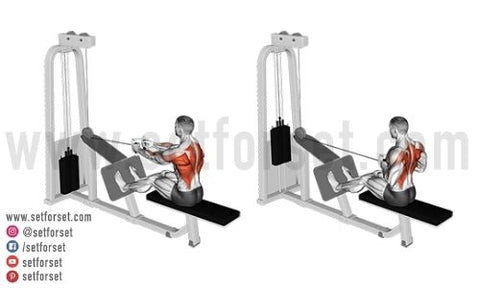Rows are the ultimate exercise for building the upper back, and cable rows are second to none among them. The seated cable row is a stellar exercise because it offers a lot of options in terms of grip and positioning that allow you to hit the back from multiple angles, maximizing muscle recruitment.
Unfortunately, we don’t always have access to a cable machine – whether you’re working out at home, your gym lacks a cable system, or the machine has just been taken over - or, you simply prefer to have some options - have no fear, you will find no shortage of alternatives for the fundamental exercises that is the row.
In this post, we’ll briefly discuss the seated cable row and how it works, and then what makes for a good alternative. After, we have the 9 best alternatives to the seated cable row. We’ll list those exercises and how to do each, along with their benefits, variations that influence the muscles they work, and ideal rep ranges to really take advantage of those movements.
Read on to learn about alternatives to the seated cable row that will have your back getting wider, thicker, and more defined in no time.

What makes for a good Seated Cable Row Alternative?
If you opt out of cable rows, a good substitute will:
- Targets the same muscles above via scapula protraction and retraction
- It will support higher rep ranges and volume
- Should be easy on the lower back
- Will support different grips
In other words, any variation of the row is ideal, and you’ll see a lot of them here. We’ll include barbell and dumbbell-based movements, and some band and TRX based movements.
Want to pack on pounds of lean muscle in 12 weeks? Check out our SFS Hypertrophy Program developed by Garett Reid (NSCA, CSCS, CISSN, M.S.E.S.S).

Prepare to maximize your gains with our exclusive 12-week hypertrophy training program. Choose between a 4 or 5 day training split and gain 2-12 pounds of muscle over 90 days...
9 Best Seated Cable Row Alternatives
Here we present our list of the 9 best seated cable row alternatives. They should somewhat replicate the range of motion and muscle recruitment of the cable row. Nothing will replace the stability of the cable row, so pay attention to form. But if you are consistent, you won’t need the cables for much longer.
1. Landmine Row (T-bar)

The landmine row (or T-bar row) is on our list of top 3 rows and is a perfect substitute for the cable row. Landmine rows afford multiple grip options; thus, you can target the same muscles as the seated row.
Additionally, they require less core activation, meaning less strain on the lower back. You can also perform these with a chest support, which takes even more pressure off the posterior chain.
How to perform:
- Secure a landmine base or put one end of a bar and bend at the hips to grab the handle.
- Keep your knees slightly bent and pull the bar towards your chest. Focus on lifting through the elbows and squeeze your shoulder blades together and back.
- Lower the weights while stretching the back forward. Pause here then repeat.
Rep range: 8-12
Related:
2. Machine High Row

The high row falls in between the row and pull ups, and it targets the lats a bit more than a seated row. But you’ll still get great activation of the upper back, and that means you can go quite a bit heavier. It also locks you into a strict range of motion, and most are capable of isolateral movements.
How to perform:
- Approach a high row machine and make necessary seating adjustments (you’ll be facing away from the machine).
- Place your back on the back pad and secure the handles above.
- Pull the handles downward and toward your chest, squeezing the lats and shoulder blades.
- Return the handles to the start, exaggerating the stretch before staring another rep.
Rep range: 8-10
Related: Machine High Row Exercise Guide
3. Dumbbell Single Arm Row

The dumbbell row is a great way to isolate each side of the back while also keeping the load heavy. The dumbbell single arm row is an isolateral movement, meaning you can control the range of motion and tension on either side.
The DB row will emphasize the lats slightly, and you’ll want to use a neutral (palms in) grip.
How to perform:
- Bend one knee over a flat bench and hold yourself upright with the same arm.
- Grasp the dumbbell from the ground with a deep stretch.
- Pull the dumbbell upwards, driving your elbow behind you and close to the hip.
- Stop when your elbow is ~90 degrees (slightly more is fine).
- Return the weight to just above the ground ensuring a good stretch in the back and repeat.
Rep range: 8-10
Related: Best Dumbbell Back Exercises
4. Seal Rows

The seal row has emerged as a popular variation of the row that can serve as a near perfect substitute to the cable row. You perform this lying face down on a bench, which takes almost all the tension off the lower back, and maximizes tension on the upper back, particularly the traps and rear delts.
You may need to find an elevated bench or use boxes to elevate the bench to perform this movement.
How to perform:
- Lie flat on a bench with a barbell underneath.
- Grasp the bar with your elbows at 90 degrees.
- Pull the bar straight toward your chest, squeezing the shoulder blades together.
- Pause before bar reaches the bottom of the bench. Return to the start with a deep stretch.
Rep range: 8-10
Related: Seal Rows Exercise Guide
5. Pendlay Rows

The Pendlay row is a variation of the barbell row but performed with the back perfectly parallel to the ground. This is more of a power movement and is sort of like a "deadlift row", in that you are bringing the bar to the ground to a dead stop each rep.
You'll maintain a bent over position the entire time, keeping your torso as parallel with the floor as possible. Perform with an overhand grip to target the lats and upper back.
How to perform:
- Approach a bar with feet hip width and knees slightly bent.
- Bend over at the hips 90 degrees and grasp the bar (keep your back straight).
- Explosively pull the bar straight up to your naval.
- Slowly return the bar completely to the ground and repeat.
Rep range: 8-10
Related: Pendlay Row Exercise Guide
6. Meadows Rows

Meadows rows are an isolateral row performed using a landmine base and barbell. These are similar in form to dumbbell rows but allow you to lift more weight through a greater range of motion. You perform this with a staggered stance, allowing you to use a little momentum to get in some fuller reps.
How to perform:
- Stand in a staggered stance perpendicular to the barbell.
- Hip hinge forward and grab the bar with an overhand grip.
- Explosively pull the bar upward, driving the elbow back and out slightly.
- Lower the bar slowly and repeat.
Rep range: 8-10
Related: Meadows Rows Exercise Guide
7. TRX Rows

TRX rows are a variation of the row that uses only bodyweight. Although they don’t generate the power or size of conventional weights, they are a great addition to any back routine, and will help you correct your form, and humility, in no time. You’ll work primarily the upper back with a bit of help from the lats.
How to perform:
- Grab TRX handles between 30”-40” from the ground with a neutral grip.
- Slowly fall backwards with your heels planted firmly until your arms are fully extended.
- Drive your elbows back and pull your torso through the handles.
- Stop when your elbows reach 90 degrees, and slowly lower your torso so your arms are fully extended again. Pause and repeat.
Rep range: 12-15
Related: 8 Must-Have Calisthenic Equipment For Your Home Gym
8. Inverted Bar Rows

Another bodyweight-based variation of the row, inverted bar rows are similar to TRX rows, but are a bit more stable. You will perform these inverted, like TRX rows, but you’ll use a barbell in a squat rack.
These will have a similar range of motion to cable rows. Keep your arms wide to target the upper back.
How to perform:
- Place a bar in a squat rack or Smith machine, ~30”-40” from the ground.
- Follow the same instructions for TRX rows, keeping your arms shoulder width apart.
- Pull your torso toward the bar; the middle of your chest should come up to the bar.
- Slowly return to the start and pause, then repeat.
Rep range: 12-15
Related: Best Smith Machine Exercises
9. Seated Resistance Band Rows

Our last row replaces weights with a resistance band but is no less effective at placing tension on the upper back. This variation is similar to the eponymous row of this article; in fact, the only difference is the weight.
You can perform this row sitting on the ground or a bench, or even upright. It will work the upper back similarly to the seated row, and can tolerate much higher reps, so is good for a starting exercise, or coupling with a superset.
How to perform:
- Sit on the floor with your back upright and legs extended to your front.
- Rap the band around a squat rack support or other vertical, stationary pole.
- Grab the bands and hold them about shoulder width apart, arms fully extended.
- Pull the band toward your lower chest, squeezing the shoulder blades.
- Stop when your elbows move just past your sides. Pause and return to the start position.
Reps: 15-20
Related: Best Resistance Band Back Exercises
What are the benefits of Seated Cable Row?
The seated cable row is a variation of the classic row and is considered an accessory back movement. It is performed seated on a bench or on the floor, and the weight is pulled horizontally toward the chest or abdominal area.
Generally speaking, seated cable rows offer a greater range of motion than bars or dumbbells.

Below are a few benefits of the seated cable row:
- Seated = less pressure on the back: Probably the most important factor, the seated position removes excess or egregious pressure on the back and legs. This provides an element of safety, as well as ease.
- Grip Options: Because you are using a cable row, you are not restricted to a bar or a dumbbell. There is a variety of grips and positions you can employ in the cable row to maximize muscle recruitment across the upper back.
- No Gravity? No Problem: The cable row relies less on gravity than traditional free weights. Cables run through pulleys to create leverage across different points. What this means is you can follow a more appropriate range of motion, promoting better form AND you will have constant tension throughout the range of motion.
Seated Cable Row Muscles Worked
The seated row works basically the entire upper back, and to a lesser extent the mid/lower back and arms. But the muscles worked depend largely upon the grip used. Here are the muscles the worked by the row, followed by different grips and the muscles they work:
- Trapezius (traps): The traps cap the shoulders and support the neck and middle back. The traps connect the scapula to the spinal column.
- Rear deltoids (delts): The rear deltoids are a group of small muscles on the posterior of the shoulder joint and connects the scapula to the upper arm.
- Rhomboids: these muscles sit beneath the traps and anchor the scapula to the spine. These aren’t considered “mirror muscles”, but you can target them for strength and size.
- Latissimus dorsi (lats): The back muscle, the lats have a wing shape and span half the length of the back. They connect the spine and upper arm.
- Teres Major/Minor: AKA the ‘lats’ little helper’, the teres major and minor sit just below the lats. They connect the scapula to the upper arm and assist in the pulling movements of the lats.
Grips:
- Narrow vs. Wide: The narrow grip emphasizes elbow flexion and shoulder adduction, which works primarily the lats (and teres groups) and biceps. The wide grip involves less flexion, and places more tension on the traps, rhomboids, and rear delts. A rule of thumb would be narrow = width; wide = thickness.
- Underhand vs. Overhand: The underhand grip mimics the narrow grip (on a straight bar) and emphasizes the lats and biceps. The overhand grip places less emphasis directly on the lats but doesn’t shift too much further onto the upper back.
- Volume and Progression: Another benefit of the seated row is that it supports higher rep ranges, meaning it stimulates hypertrophy and promotes quicker recovery. Rows also generously support progressing up in weight and transitioning to other exercises.

Summary and Final Thoughts
There you have it – the best alternatives to the seated cable row. The cable row really is a fundamental exercise for overall back development. It allows you to emphasize the upper back while relieving tension on the lower back, a common downside to many barbell back exercises.
We picked these exercises because they share similar characteristics as the seated cable row: range of motion through the upper back, less tension on the lower back, mid-back activation, and similar rep range tolerance.
Of course, some of these movements are better for development if performed in a lower rep range. That said, they are perfectly suitable for maximizing tension on the upper back and middle back. They are compound movements, so should be one of your primary lifts.
We hope you enjoy these exercises. Don’t forget to add on a few extra reps!
Related:












Garett Reid
Author